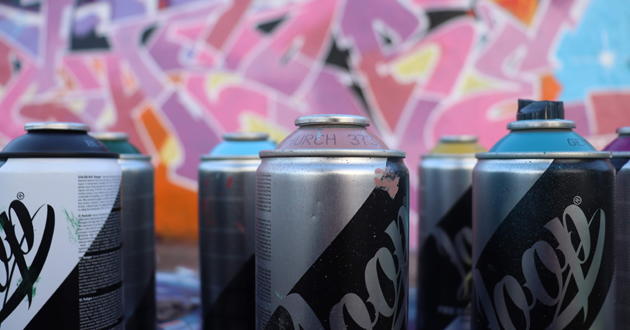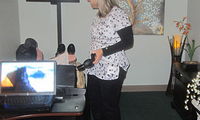Inhalant Abuse and Addiction Treatment
 Inhalants, sourced from many common household products, pose dangers of psychological and physical dependence among those who use or abuse them. As part of inhalant use, products containing volatile substances from easily sourced products, such as glues, markers, lighter fluids, and whipping cream cans, are inhaled to achieve a quick high. When inhaled through the mouth or nose, most inhalants act on the central nervous system to produce psychoactive or mind-altering effects in the user, similar to that of alcohol intoxication.
Inhalants, sourced from many common household products, pose dangers of psychological and physical dependence among those who use or abuse them. As part of inhalant use, products containing volatile substances from easily sourced products, such as glues, markers, lighter fluids, and whipping cream cans, are inhaled to achieve a quick high. When inhaled through the mouth or nose, most inhalants act on the central nervous system to produce psychoactive or mind-altering effects in the user, similar to that of alcohol intoxication.
According to a national survey conducted by the National Institute on Drug Abuse, 21.7 million Americans aged 12 and older have used inhalants at least once in their lives. In addition, the same study estimates that 13.1 percent of 8th-graders have used inhalants at some point in their life. Although many other drugs can be inhaled to produce a high, the term ‘inhalant’ refers specifically to substances that fall into one of the four following categories:
- Volatile solvents: These are liquid substances which at room temperature become gases or vapor that can then be inhaled. These substances can be easily sourced and include paint thinner, gasoline, glues, corrector fluid, degreasers, dry cleaning fluids and paint removers.
- Aerosols: these are sprays that contain propellants and solvents. Examples of aerosols that are often abused include deodorant sprays, cooking oil sprays and hair sprays.
- Gases: these include gases meant for household, industrial or medical uses. These include ether, nitrous oxide, chloroform, butane lighter fluid and halothane.
- Nitrites: substances under this category differ from substances in the other three categories in the way they effect the body once inhaled. Instead of targeting the central nervous system, nitrites dilate blood vessels and relax muscles. Nitrites are often used as sexual enhancers and can be found in products such as video head cleaners and leather cleaner. Nitrites, also referred to as poppers, snappers or rush, are popular among clubbers.
Inhalant Methods of Use and Street Names
Although all inhalants are breathed in through the mouth or nose, the method of doing so may differ depending on the substance.
Aerosols and gases are often sprayed into a paper or plastic bag that is then placed over a person's mouth and nose to be inhaled. This is popularly referred to as huffing or bagging.
Nitrites can be similarly inhaled by filling them inside of balloons. This is simply referred to as inhaling.
Solvents are doused onto a rag, cotton ball or a person's sleeve that are then used to cover one's face so it can be inhaled. solvents are also inhaled directly out of their containers, a practice referred to as sniffing.
The use of inhalants goes by many additional street names including air blast, bang, bullet bolt, high ball, moon gas, quicksilver, whippets, laughing gas, Oz and Texas shoe-shine.
Signs of Inhalant Use and Addiction
There are many tell-tale signs that an individual may be using inhalants but perhaps the most significant sign is smell. Many of these chemical substances have strong odors that can linger on a person’s clothes, skin and hair. A chemical odor may also be present on their breath. Other signs of inhalant use and addiction to look for include:
- Paint stains on clothes or face
- Slurred speech and disorientation
- Sores or burn spots around the mouth
- Red eyes and nose
- Dazed appearance or irritability
- Loss of appetite and weight loss
Dangers and Side-Effects of Inhalant Use
Any use of inhalants is extremely dangerous as these substances are toxic. Even a casual or first-time user of inhalants run the risk of suffering serious side effects, namely sudden sniffing death, which occurs due to disruption of normal heart rhythms causing the heart to abruptly stop. Other serious side effect of inhalant use include:
- Damage to liver, kidneys and other organs.
- Suffocation due to lack of oxygen
- Hearing loss
- Bone marrow damage
- Loss of coordination and limb spasms due to nerve damage
- Behavorial issues
- Brain damage due to lack of oxygen to the brain
- Seizures and/or coma
However, some of the damage to organs and nerves is reversable once inhalant use has stopped.
Treatment of Inhalant Abuse
The prolonged use of inhalants can build tolerance causing individuals to use inhalants more frequently to produce the same level of high. People who use inhalants may also be at higher risk of developing other substance abuse disorders due to prolong use. Although physical addiction is not as common as phycological, some individuals may experience withdrawal symptoms when the cease use of inhalants. Symptoms of withdrawal can include nausea, loss of appetite, sweating, problems sleeping and mood changes. Since the chemicals found in many inhalants can persist in the body for several weeks, patients may experience these symptoms for up to a month after cessation and detox has begun.
Because physical addiction to inhalants is uncommon, the individuals dealing with inhalant abuse are encouraged to take part in cognitive-behavioral therapy. This form of therapy helps individuals recognize their personal triggers so they can avoid or better cope with situations in which they would have likely used drugs.
It is also important to access an individual's overall health for any damage cause due to prolonged chemical exposure.
Drug Rehab Options
- Residential Treatment: At residential treatment facilities, individuals have unrestricted access to medical and psychiatric care. They are free to focus on their recovery in a supportive environment, free from the worries and demands of their personal life. Individual, group and family therapy are also incorporated in many residential programs. Individuals can also take advantage of more holistic therapies and recreational programs such as yoga, and swimming.
- Outpatient Treatment: Once a patient has complete treatment in a residential treatment facility, they may find in beneficial to continue their treatment in an outpatient setting. Outpatient programs are also beneficial for those who cannot take time off from work, school or the other demands of life. There are a few different types of outpatient treatment options available depending on the time commitment an individual can make. Some outpatient programs require a full day attendance to the program, others require a half day commitment and yet others only require a few hours of an individual's time once or twice a week.
Addiction and substance abuse treatment does not respond to a one-size- fits-all approach. Successful treatment and long-lasting results require unique approaches for unique individuals. Whatever your particular circumstances, there is a right treatment option out there just for you.










